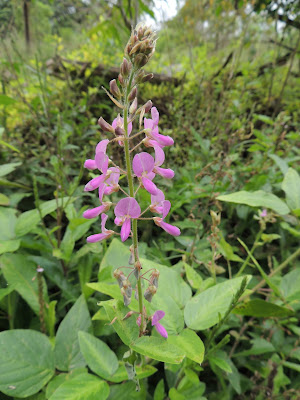Belongs within: Desmodieae.
Desmodium, tick clovers, is a genus of leguminous herbs and shrubs found in warmer parts of the world, a number of which have seeds covered in tiny hooked hairs that stick to animal skins or clothes for dispersal. Though species may be regarded as invasive weeds in some areas, some such as the Asian tick-trefoil D. heterocarpon and D. intortum are inter-cropped among grain fields due to their production of secondary metabolites that can ward off pests.
Characters (from Flora of China): Herbs, subshrubs, or shrubs. Leaves pinnately 3-foliolate or 1-foliolate by reduction of lateral leaflets, stipulate, stipellate. Flowers usually smaller, in racemes or panicles, axillary or terminal, rarely solitary or binate in leaf axils. Bracts persistent or early deciduous; bracteoles present or absent. Calyx campanulate, 4- or 5-lobed, bilabiate; upper 2 lobes connate for all or most of length, entire or 2-toothed at apex, lower lobes free, longest. Corolla white, green-white, pink, purple, or violet; standard elliptic or obovate to nearly orbicular; wings more or less adherent to keel, wholly clawed. Stamens diadelphous (9+1), rarely monadelphous. Ovary usually sessile, with several to many ovules. Legume compressed, usually indehiscent, transversely segmented, upper (adaxial) suture slightly constricted or straight, lower (abaxial) one constricted; articles mostly ellipsoidal to quadrangular. Cotyledons epigeous.
<==Desmodium
|--D. axillare J87
|--D. barbatum CP13
|--D. brownii LK14
|--D. diffusum P03
|--D. filiforme LK14
|--D. gangeticum LK14
|--D. glareosum LK14
|--D. hannii LK14
|--D. heterocarpon LK14
| |--D. h. var. heterocarpon LK14
| `--D. h. var. strigosum LK14
|--D. incanum C55
|--D. intortum MM96
|--D. muelleri LK14
|--D. ormocarpoides B00
|--D. ovalifolium S00
|--D. paniculatum W10
|--D. pulchellum P03
|--D. pullenii LK14
|--D. pycnotrichum LK14
|--D. repandum BMM99
|--D. scorpiurus (Swartz) Desvaux 1813 [=Hedysarum scorpiurus Swartz 1788] GB02
|--D. tortuosum LK14
|--D. trichostachyum LK14
|--D. triflorum LK14 [=Hedysarum triflorum C55; incl. Nicolsonia reptans C55]
|--D. umbellatum P88
|--D. velutinum P03
`--D. zonatum Miq. 1855 [=Meiobomia zonatum (Miq.) Kuntze 1891] SR07
*Type species of generic name indicated
REFERENCES
[B00] Braby, M. F. 2000. Butterflies of Australia: their identification, biology and distribution vol. 2. CSIRO Publishing: Collingwood (Victoria).
[BMM99] Braun, U., J. Mouchacca & E. H. C. McKenzie. 1999. Cercosporoid hyphomycetes from New Caledonia and some other South Pacific islands. New Zealand Journal of Botany 37: 297–327.
[C55] Candolle, A. de. 1855. Géographie Botanique Raisonée: Ou exposition des faits principaux et des lois concernant la distribution géographique des plantes de l’époque actuelle vol. 2. Librairie de Victor Masson: Paris.
[CP13] Cardoso, D., R. T. Pennington, L. P. de Queiroz, J. S. Boatwright, B.-E. Van Wyk, M. F. Wojciechowski & M. Lavin. 2013. Reconstructing the deep-branching relationships of the papilionoid legumes. South African Journal of Botany 89: 58–75.
[GB02] Gopalakrishna Bhat, K. 2002. Additions to the flora of Karnataka. Journal of the Bombay Natural History Society 99 (3): 566–567.
[J87] Judd, W. S. 1987. Floristic study of Morne La Visite and Pic Macaya National Parks, Haiti. Bulletin of the Florida State Museum—Biological Sciences 32 (1): 1–136.
[LK14] Lyons, M. N., G. J. Keighery, L. A. Gibson & T. Handasyde. 2014. Flora and vegetation communities of selected islands off the Kimberley coast of Western Australia. Records of the Western Australian Museum Supplement 81: 205–244.
[MM96] Mound, L. A., & R. Marullo. 1996. The thrips of Central and South America: an introduction (Insecta: Thysanoptera). Memoirs on Entomology, International 6: 1–487.
[P03] Paul, T. K. 2003. Botanical observations on the Purulia pumped storage hydropower project area, Bagmundi Hills, Purulia district, West Bengal. Bulletin of the Botanical Survey of India 45: 121–142.
[P88] Polunin, I. 1988. Plants and Flowers of Malaysia. Times Editions: Singapore.
[SR07] Sankar, R. V., K. Ravikumar, N. M. Ganesh Babu & D. K. Ved. 2007. Botany of Anapady MPCA, Palghat district, Kerala with special emphasis on species of conservation concern. Bulletin of the Botanical Survey of India 49: 165–172.
[S00] Siddiqi, M. R. 2000. Tylenchida: Parasites of plants and insects 2nd ed. CABI Publishing: Wallingford (UK).
[W10] Whittington, A. E. 2010. Platystomatidae (signal flies). In: Brown, B. V., A. Borkent, J. M. Cumming, D. M. Wood, N. E. Woodley & M. A. Zumbado (eds) Manual of Central American Diptera vol. 2 pp. 903–907. NRC Research Press: Ottawa.
Last updated: 20 September 2020.

No comments:
Post a Comment
Markup Key:
- <b>bold</b> = bold
- <i>italic</i> = italic
- <a href="http://www.fieldofscience.com/">FoS</a> = FoS